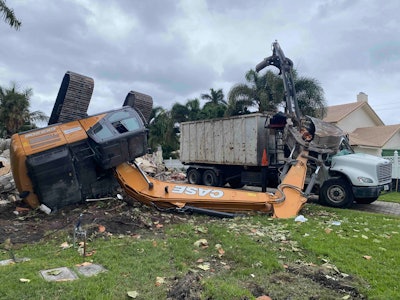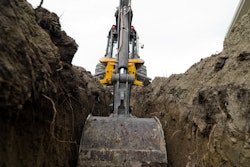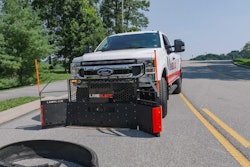
An excavator being used to clear debris from a home being demolished tipped over and killed a man in Delray Beach, Florida.
The excavator’s bucket grapple attachment landed on top of a haul truck killing the occupant, according to local authorities. The man was taken to the hospital where he was pronounced dead November 9, Delray Beach Fire Rescue reported.
The excavator operator was not injured, according to WPTV. The news station quoted a witness who said the Case excavator was on a mound of debris when it tipped over and its grapple bucket landed on the truck that was equipped with a boom and grapple. A surveillance video obtained by WPTV shows the excavator on a mound of debris with tracks perpendicular to the debris topple over backward.
No further information has been released about the incident.
Excavator Operation Tips
Here are some excavator safety tips, according to the “Excavation Equipment Operation Safety Guidelines,” Ohio State University’s College of Food, Agricultural and Environmental Sciences:
- Trained Operators – Only persons with prior training and experience are permitted to operate an excavator. Operational training should be done under direct supervision of supervisor and documentation of the training shall be maintained by the department.
- Caution Area – A designated caution perimeter should be maintained around excavations, by using barriers, caution tape and/or signage. The size of the caution perimeter is to be 6 feet greater than (when available) the reach of the skid loader. Observers are to remain outside this perimeter at all times.
- Spotter/Safety Monitor – A spotter/safety monitor must assist the excavator operator when digging in areas of potential hazard from electrical or gas utilities or when working in high pedestrian activity areas.
- Workers Within the Excavation – No worker is allowed within the excavation while the end of the backhoe arm is also within the excavation. Workers must exit to a safe location while materials are being positioned above or lowered into the excavation. While a person is within the excavation, the backhoe arm shall be positioned away from the top edge of the excavation, so that the end of the arm cannot reach the worker, in case of an inadvertent activation.
Excavator Safety Tips: During Operation
- Never permit riders in the bucket, cab, or anywhere else on the machine. Excavators only have one seat, which is meant for the operator.
- Never attempt to operate the excavator unless you are sitting in the seat and in full control.
- Reduce the excavator’s speed when working on rough terrain or within congested areas.
- Carry the bucket low to the ground during transport. This will increase visibility and machine stability.
- When moving the excavator around the job site, select a route that is as flat as possible.
- Steer the machine as straight as possible and only make small gradual changes in direction when turning is needed.
- Travel directly up slopes vertically instead of diagonally.
- When propelling up slopes, the boom and the arm should be extended with the bucket carried low and rolled out. This will allow you to drop the bucket and prevent the equipment from sliding if necessary.
- When propelling down a slope, the bucket bottom should be low and parallel to the ground.
- In very steep or slippery conditions, you can use the boom and arm to help move up and down the slope. When going up a steep slope, extend the boom and arm, and when needed, lower the bucket and retract the arm to help pull the machine up. When traveling down a steep slope, position the bucket with the flat surface resting on the ground. While retracting the arm, raise the boom and propel the machine until the front of the tracks reach ground level.
- When using the excavator for trenching, make sure the machine is level by placing dirt underneath the tracks. Being level will make the trench vertical and will help to avoid cave-ins.
- For better stability, work with the propel motors to the rear of the machine.
- Dump spoil piles as far away from the excavation as possible to avoid cave-ins.
- When doing excavation jobs on slopes, level the machine by digging a shelf (or bench cut). Material removed from the upper slope can be used to build up the lower slope and create a level surface.
- On steep bench cuts, cut enough away from the upper bank to allow for adequate swing clearance when casting downslope.
- Never dig underneath the excavator.
- When backfilling a cave-in, the excavator’s tracks should be at a 90-degree angle to the excavation with the propel motors to the rear of the machine.
- When loading trucks, never swing the excavator bucket over the truck cab. By swinging over the rear of the truck, any loose materials will fall on the ground or in the bed, rather than on the cab.
- Never attempt the clean the excavator’s bucket by striking it on the ground or against another object.










